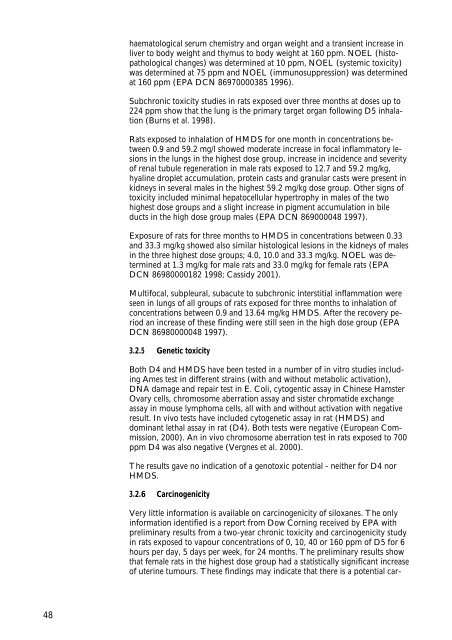No. 1031 - Miljøstyrelsen
No. 1031 - Miljøstyrelsen
No. 1031 - Miljøstyrelsen
Create successful ePaper yourself
Turn your PDF publications into a flip-book with our unique Google optimized e-Paper software.
48<br />
haematological serum chemistry and organ weight and a transient increase in<br />
liver to body weight and thymus to body weight at 160 ppm. NOEL (histopathological<br />
changes) was determined at 10 ppm, NOEL (systemic toxicity)<br />
was determined at 75 ppm and NOEL (immunosuppression) was determined<br />
at 160 ppm (EPA DCN 86970000385 1996).<br />
Subchronic toxicity studies in rats exposed over three months at doses up to<br />
224 ppm show that the lung is the primary target organ following D5 inhalation<br />
(Burns et al. 1998).<br />
Rats exposed to inhalation of HMDS for one month in concentrations between<br />
0.9 and 59.2 mg/l showed moderate increase in focal inflammatory lesions<br />
in the lungs in the highest dose group, increase in incidence and severity<br />
of renal tubule regeneration in male rats exposed to 12.7 and 59.2 mg/kg,<br />
hyaline droplet accumulation, protein casts and granular casts were present in<br />
kidneys in several males in the highest 59.2 mg/kg dose group. Other signs of<br />
toxicity included minimal hepatocellular hypertrophy in males of the two<br />
highest dose groups and a slight increase in pigment accumulation in bile<br />
ducts in the high dose group males (EPA DCN 869000048 1997).<br />
Exposure of rats for three months to HMDS in concentrations between 0.33<br />
and 33.3 mg/kg showed also similar histological lesions in the kidneys of males<br />
in the three highest dose groups; 4.0, 10.0 and 33.3 mg/kg. NOEL was determined<br />
at 1.3 mg/kg for male rats and 33.0 mg/kg for female rats (EPA<br />
DCN 86980000182 1998; Cassidy 2001).<br />
Multifocal, subpleural, subacute to subchronic interstitial inflammation were<br />
seen in lungs of all groups of rats exposed for three months to inhalation of<br />
concentrations between 0.9 and 13.64 mg/kg HMDS. After the recovery period<br />
an increase of these finding were still seen in the high dose group (EPA<br />
DCN 86980000048 1997).<br />
3.2.5 Genetic toxicity<br />
Both D4 and HMDS have been tested in a number of in vitro studies including<br />
Ames test in different strains (with and without metabolic activation),<br />
DNA damage and repair test in E. Coli, cytogentic assay in Chinese Hamster<br />
Ovary cells, chromosome aberration assay and sister chromatide exchange<br />
assay in mouse lymphoma cells, all with and without activation with negative<br />
result. In vivo tests have included cytogenetic assay in rat (HMDS) and<br />
dominant lethal assay in rat (D4). Both tests were negative (European Commission,<br />
2000). An in vivo chromosome aberration test in rats exposed to 700<br />
ppm D4 was also negative (Vergnes et al. 2000).<br />
The results gave no indication of a genotoxic potential - neither for D4 nor<br />
HMDS.<br />
3.2.6 Carcinogenicity<br />
Very little information is available on carcinogenicity of siloxanes. The only<br />
information identified is a report from Dow Corning received by EPA with<br />
preliminary results from a two-year chronic toxicity and carcinogenicity study<br />
in rats exposed to vapour concentrations of 0, 10, 40 or 160 ppm of D5 for 6<br />
hours per day, 5 days per week, for 24 months. The preliminary results show<br />
that female rats in the highest dose group had a statistically significant increase<br />
of uterine tumours. These findings may indicate that there is a potential car-

















